Occupational Hygiene: Building Air Conditioning Maintenance Program
VerifiedAdded on 2023/06/03
|14
|3027
|476
Project
AI Summary
This research proposal, focused on occupational hygiene, investigates the crucial link between indoor air quality and the maintenance of air conditioning systems within buildings. The proposal begins with an abstract highlighting the importance of a healthy indoor environment for comfort, productivity, and well-being, emphasizing the role of air quality and the impact of factors like humidity and temperature. An introduction elaborates on the significance of good indoor air quality in workplaces, classrooms, and residential settings, contrasting natural and mechanical ventilation systems. The literature review delves into the parameters of indoor air quality, the impact of pollutants, and the effects of poor air quality on health and productivity, referencing various research studies and industry codes of practice. The proposal also addresses gaps in the literature, such as the effects of poor maintenance and unregulated modifications of air conditioning systems and outlines the scope of the research, including the research aim, questions, and objectives. The proposal concludes by restating the importance of a healthy indoor environment and promises to provide a maintenance program for air conditioning systems to ensure the best indoor air quality and a comfortable and safe working environment. The proposal also includes a detailed maintenance schedule to show the periodicity of the activities and their relevance.
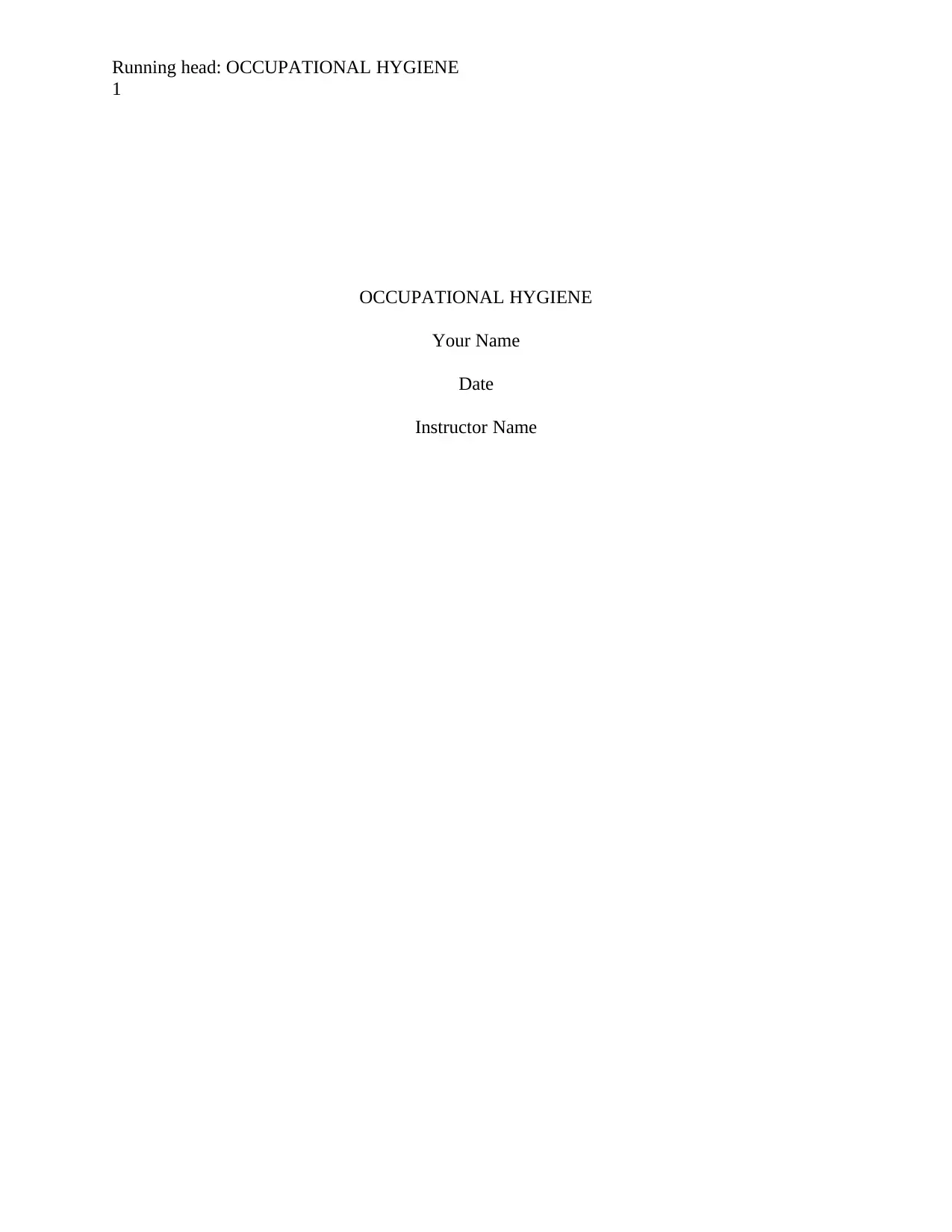
Running head: OCCUPATIONAL HYGIENE
1
OCCUPATIONAL HYGIENE
Your Name
Date
Instructor Name
1
OCCUPATIONAL HYGIENE
Your Name
Date
Instructor Name
Paraphrase This Document
Need a fresh take? Get an instant paraphrase of this document with our AI Paraphraser
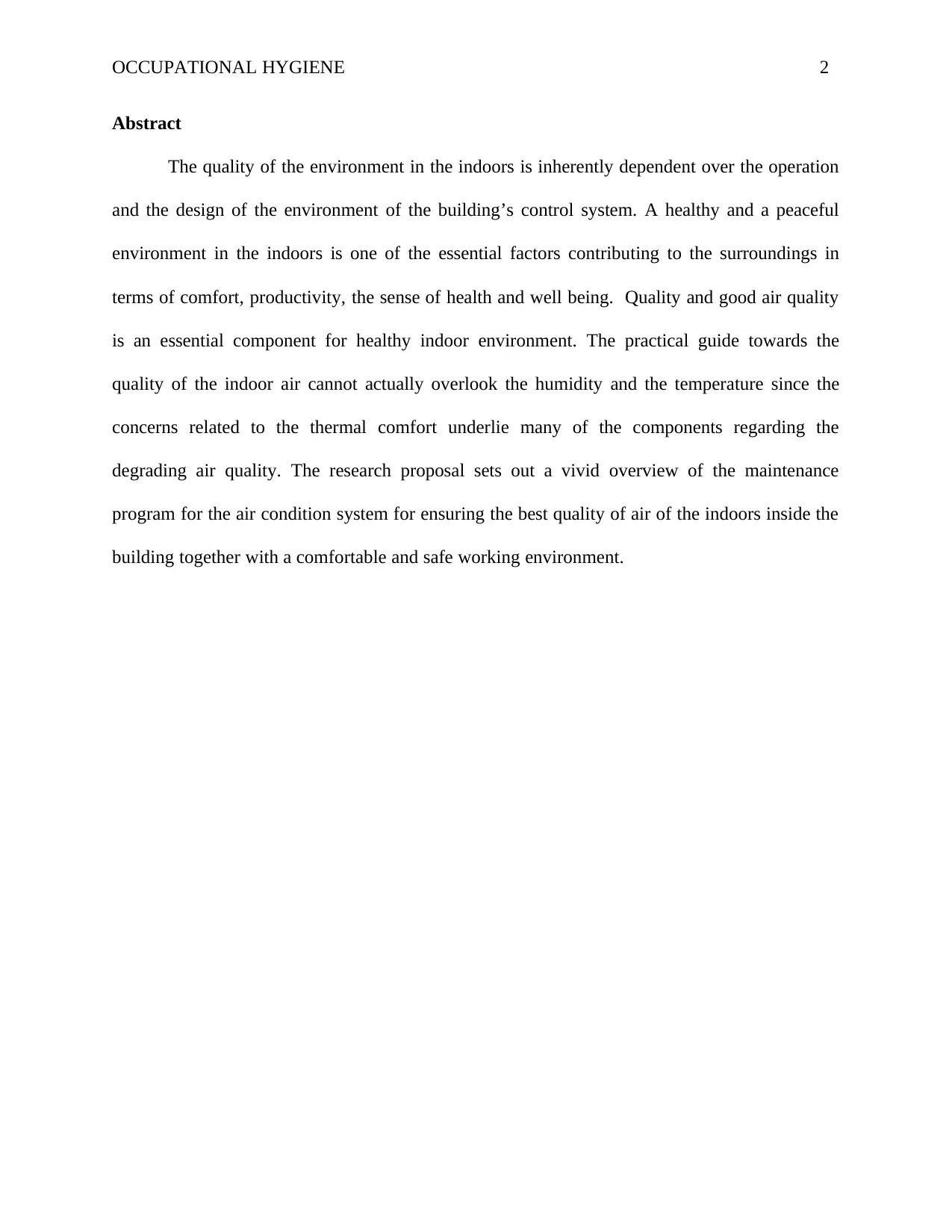
OCCUPATIONAL HYGIENE 2
Abstract
The quality of the environment in the indoors is inherently dependent over the operation
and the design of the environment of the building’s control system. A healthy and a peaceful
environment in the indoors is one of the essential factors contributing to the surroundings in
terms of comfort, productivity, the sense of health and well being. Quality and good air quality
is an essential component for healthy indoor environment. The practical guide towards the
quality of the indoor air cannot actually overlook the humidity and the temperature since the
concerns related to the thermal comfort underlie many of the components regarding the
degrading air quality. The research proposal sets out a vivid overview of the maintenance
program for the air condition system for ensuring the best quality of air of the indoors inside the
building together with a comfortable and safe working environment.
Abstract
The quality of the environment in the indoors is inherently dependent over the operation
and the design of the environment of the building’s control system. A healthy and a peaceful
environment in the indoors is one of the essential factors contributing to the surroundings in
terms of comfort, productivity, the sense of health and well being. Quality and good air quality
is an essential component for healthy indoor environment. The practical guide towards the
quality of the indoor air cannot actually overlook the humidity and the temperature since the
concerns related to the thermal comfort underlie many of the components regarding the
degrading air quality. The research proposal sets out a vivid overview of the maintenance
program for the air condition system for ensuring the best quality of air of the indoors inside the
building together with a comfortable and safe working environment.
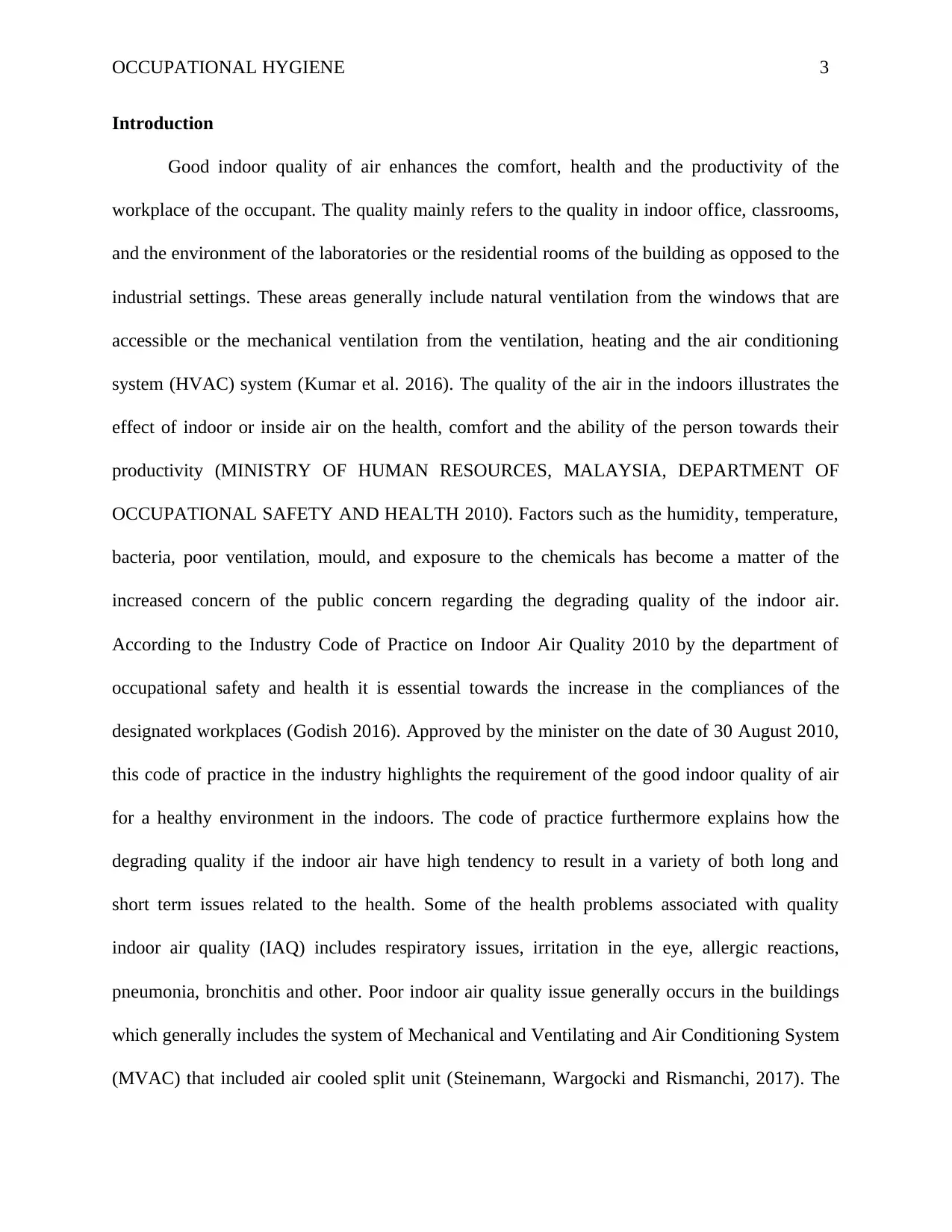
OCCUPATIONAL HYGIENE 3
Introduction
Good indoor quality of air enhances the comfort, health and the productivity of the
workplace of the occupant. The quality mainly refers to the quality in indoor office, classrooms,
and the environment of the laboratories or the residential rooms of the building as opposed to the
industrial settings. These areas generally include natural ventilation from the windows that are
accessible or the mechanical ventilation from the ventilation, heating and the air conditioning
system (HVAC) system (Kumar et al. 2016). The quality of the air in the indoors illustrates the
effect of indoor or inside air on the health, comfort and the ability of the person towards their
productivity (MINISTRY OF HUMAN RESOURCES, MALAYSIA, DEPARTMENT OF
OCCUPATIONAL SAFETY AND HEALTH 2010). Factors such as the humidity, temperature,
bacteria, poor ventilation, mould, and exposure to the chemicals has become a matter of the
increased concern of the public concern regarding the degrading quality of the indoor air.
According to the Industry Code of Practice on Indoor Air Quality 2010 by the department of
occupational safety and health it is essential towards the increase in the compliances of the
designated workplaces (Godish 2016). Approved by the minister on the date of 30 August 2010,
this code of practice in the industry highlights the requirement of the good indoor quality of air
for a healthy environment in the indoors. The code of practice furthermore explains how the
degrading quality if the indoor air have high tendency to result in a variety of both long and
short term issues related to the health. Some of the health problems associated with quality
indoor air quality (IAQ) includes respiratory issues, irritation in the eye, allergic reactions,
pneumonia, bronchitis and other. Poor indoor air quality issue generally occurs in the buildings
which generally includes the system of Mechanical and Ventilating and Air Conditioning System
(MVAC) that included air cooled split unit (Steinemann, Wargocki and Rismanchi, 2017). The
Introduction
Good indoor quality of air enhances the comfort, health and the productivity of the
workplace of the occupant. The quality mainly refers to the quality in indoor office, classrooms,
and the environment of the laboratories or the residential rooms of the building as opposed to the
industrial settings. These areas generally include natural ventilation from the windows that are
accessible or the mechanical ventilation from the ventilation, heating and the air conditioning
system (HVAC) system (Kumar et al. 2016). The quality of the air in the indoors illustrates the
effect of indoor or inside air on the health, comfort and the ability of the person towards their
productivity (MINISTRY OF HUMAN RESOURCES, MALAYSIA, DEPARTMENT OF
OCCUPATIONAL SAFETY AND HEALTH 2010). Factors such as the humidity, temperature,
bacteria, poor ventilation, mould, and exposure to the chemicals has become a matter of the
increased concern of the public concern regarding the degrading quality of the indoor air.
According to the Industry Code of Practice on Indoor Air Quality 2010 by the department of
occupational safety and health it is essential towards the increase in the compliances of the
designated workplaces (Godish 2016). Approved by the minister on the date of 30 August 2010,
this code of practice in the industry highlights the requirement of the good indoor quality of air
for a healthy environment in the indoors. The code of practice furthermore explains how the
degrading quality if the indoor air have high tendency to result in a variety of both long and
short term issues related to the health. Some of the health problems associated with quality
indoor air quality (IAQ) includes respiratory issues, irritation in the eye, allergic reactions,
pneumonia, bronchitis and other. Poor indoor air quality issue generally occurs in the buildings
which generally includes the system of Mechanical and Ventilating and Air Conditioning System
(MVAC) that included air cooled split unit (Steinemann, Wargocki and Rismanchi, 2017). The
You're viewing a preview
Unlock full access by subscribing today!
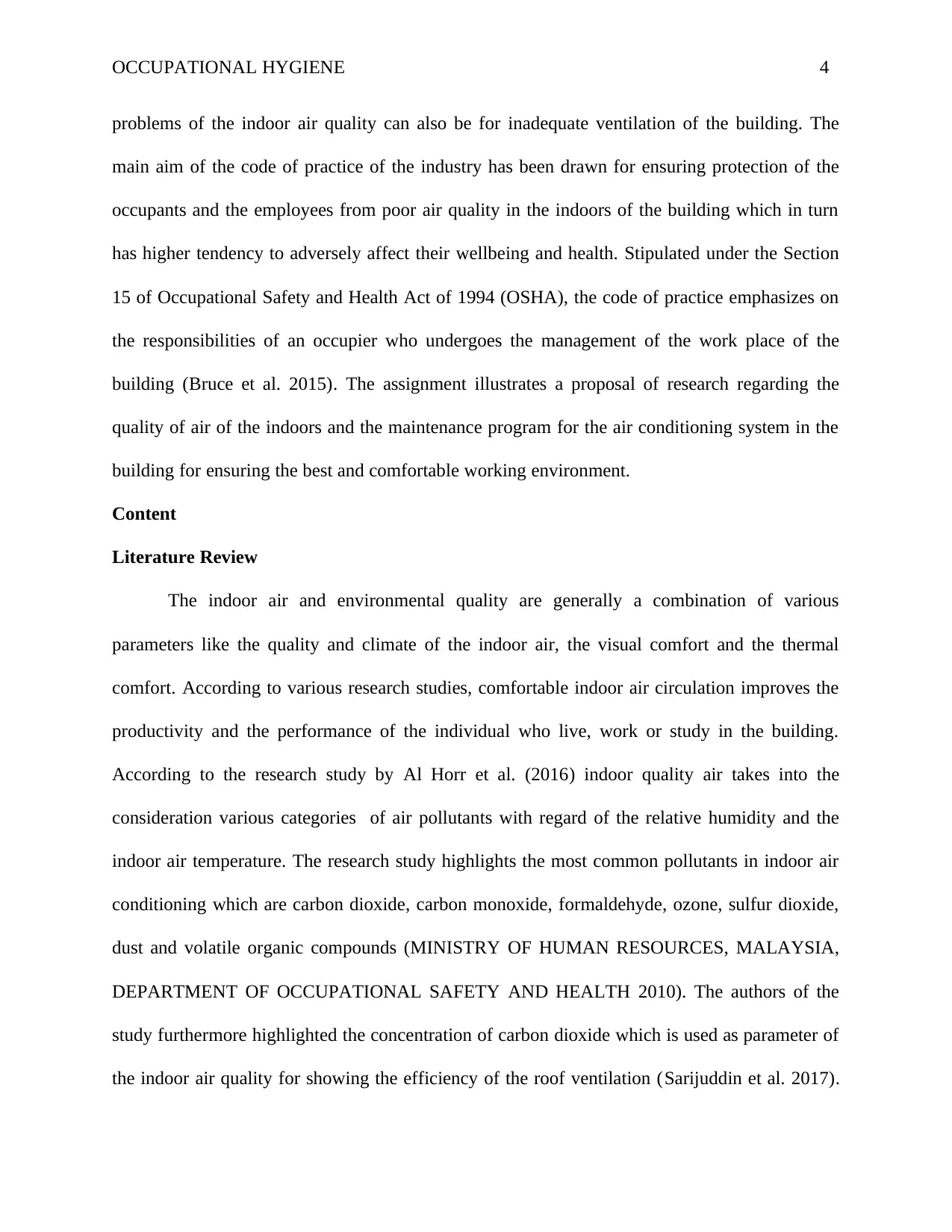
OCCUPATIONAL HYGIENE 4
problems of the indoor air quality can also be for inadequate ventilation of the building. The
main aim of the code of practice of the industry has been drawn for ensuring protection of the
occupants and the employees from poor air quality in the indoors of the building which in turn
has higher tendency to adversely affect their wellbeing and health. Stipulated under the Section
15 of Occupational Safety and Health Act of 1994 (OSHA), the code of practice emphasizes on
the responsibilities of an occupier who undergoes the management of the work place of the
building (Bruce et al. 2015). The assignment illustrates a proposal of research regarding the
quality of air of the indoors and the maintenance program for the air conditioning system in the
building for ensuring the best and comfortable working environment.
Content
Literature Review
The indoor air and environmental quality are generally a combination of various
parameters like the quality and climate of the indoor air, the visual comfort and the thermal
comfort. According to various research studies, comfortable indoor air circulation improves the
productivity and the performance of the individual who live, work or study in the building.
According to the research study by Al Horr et al. (2016) indoor quality air takes into the
consideration various categories of air pollutants with regard of the relative humidity and the
indoor air temperature. The research study highlights the most common pollutants in indoor air
conditioning which are carbon dioxide, carbon monoxide, formaldehyde, ozone, sulfur dioxide,
dust and volatile organic compounds (MINISTRY OF HUMAN RESOURCES, MALAYSIA,
DEPARTMENT OF OCCUPATIONAL SAFETY AND HEALTH 2010). The authors of the
study furthermore highlighted the concentration of carbon dioxide which is used as parameter of
the indoor air quality for showing the efficiency of the roof ventilation (Sarijuddin et al. 2017).
problems of the indoor air quality can also be for inadequate ventilation of the building. The
main aim of the code of practice of the industry has been drawn for ensuring protection of the
occupants and the employees from poor air quality in the indoors of the building which in turn
has higher tendency to adversely affect their wellbeing and health. Stipulated under the Section
15 of Occupational Safety and Health Act of 1994 (OSHA), the code of practice emphasizes on
the responsibilities of an occupier who undergoes the management of the work place of the
building (Bruce et al. 2015). The assignment illustrates a proposal of research regarding the
quality of air of the indoors and the maintenance program for the air conditioning system in the
building for ensuring the best and comfortable working environment.
Content
Literature Review
The indoor air and environmental quality are generally a combination of various
parameters like the quality and climate of the indoor air, the visual comfort and the thermal
comfort. According to various research studies, comfortable indoor air circulation improves the
productivity and the performance of the individual who live, work or study in the building.
According to the research study by Al Horr et al. (2016) indoor quality air takes into the
consideration various categories of air pollutants with regard of the relative humidity and the
indoor air temperature. The research study highlights the most common pollutants in indoor air
conditioning which are carbon dioxide, carbon monoxide, formaldehyde, ozone, sulfur dioxide,
dust and volatile organic compounds (MINISTRY OF HUMAN RESOURCES, MALAYSIA,
DEPARTMENT OF OCCUPATIONAL SAFETY AND HEALTH 2010). The authors of the
study furthermore highlighted the concentration of carbon dioxide which is used as parameter of
the indoor air quality for showing the efficiency of the roof ventilation (Sarijuddin et al. 2017).
Paraphrase This Document
Need a fresh take? Get an instant paraphrase of this document with our AI Paraphraser
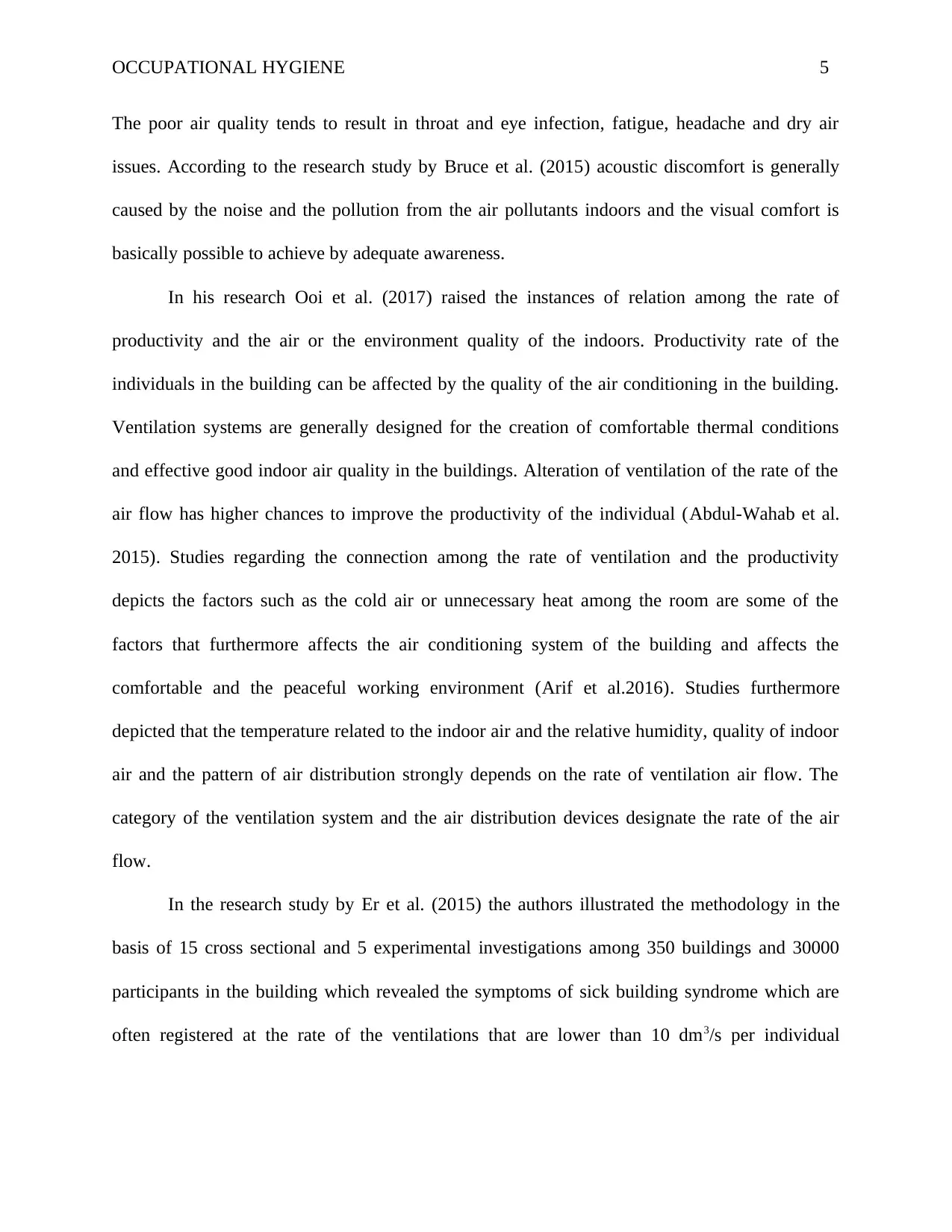
OCCUPATIONAL HYGIENE 5
The poor air quality tends to result in throat and eye infection, fatigue, headache and dry air
issues. According to the research study by Bruce et al. (2015) acoustic discomfort is generally
caused by the noise and the pollution from the air pollutants indoors and the visual comfort is
basically possible to achieve by adequate awareness.
In his research Ooi et al. (2017) raised the instances of relation among the rate of
productivity and the air or the environment quality of the indoors. Productivity rate of the
individuals in the building can be affected by the quality of the air conditioning in the building.
Ventilation systems are generally designed for the creation of comfortable thermal conditions
and effective good indoor air quality in the buildings. Alteration of ventilation of the rate of the
air flow has higher chances to improve the productivity of the individual (Abdul-Wahab et al.
2015). Studies regarding the connection among the rate of ventilation and the productivity
depicts the factors such as the cold air or unnecessary heat among the room are some of the
factors that furthermore affects the air conditioning system of the building and affects the
comfortable and the peaceful working environment (Arif et al.2016). Studies furthermore
depicted that the temperature related to the indoor air and the relative humidity, quality of indoor
air and the pattern of air distribution strongly depends on the rate of ventilation air flow. The
category of the ventilation system and the air distribution devices designate the rate of the air
flow.
In the research study by Er et al. (2015) the authors illustrated the methodology in the
basis of 15 cross sectional and 5 experimental investigations among 350 buildings and 30000
participants in the building which revealed the symptoms of sick building syndrome which are
often registered at the rate of the ventilations that are lower than 10 dm3/s per individual
The poor air quality tends to result in throat and eye infection, fatigue, headache and dry air
issues. According to the research study by Bruce et al. (2015) acoustic discomfort is generally
caused by the noise and the pollution from the air pollutants indoors and the visual comfort is
basically possible to achieve by adequate awareness.
In his research Ooi et al. (2017) raised the instances of relation among the rate of
productivity and the air or the environment quality of the indoors. Productivity rate of the
individuals in the building can be affected by the quality of the air conditioning in the building.
Ventilation systems are generally designed for the creation of comfortable thermal conditions
and effective good indoor air quality in the buildings. Alteration of ventilation of the rate of the
air flow has higher chances to improve the productivity of the individual (Abdul-Wahab et al.
2015). Studies regarding the connection among the rate of ventilation and the productivity
depicts the factors such as the cold air or unnecessary heat among the room are some of the
factors that furthermore affects the air conditioning system of the building and affects the
comfortable and the peaceful working environment (Arif et al.2016). Studies furthermore
depicted that the temperature related to the indoor air and the relative humidity, quality of indoor
air and the pattern of air distribution strongly depends on the rate of ventilation air flow. The
category of the ventilation system and the air distribution devices designate the rate of the air
flow.
In the research study by Er et al. (2015) the authors illustrated the methodology in the
basis of 15 cross sectional and 5 experimental investigations among 350 buildings and 30000
participants in the building which revealed the symptoms of sick building syndrome which are
often registered at the rate of the ventilations that are lower than 10 dm3/s per individual
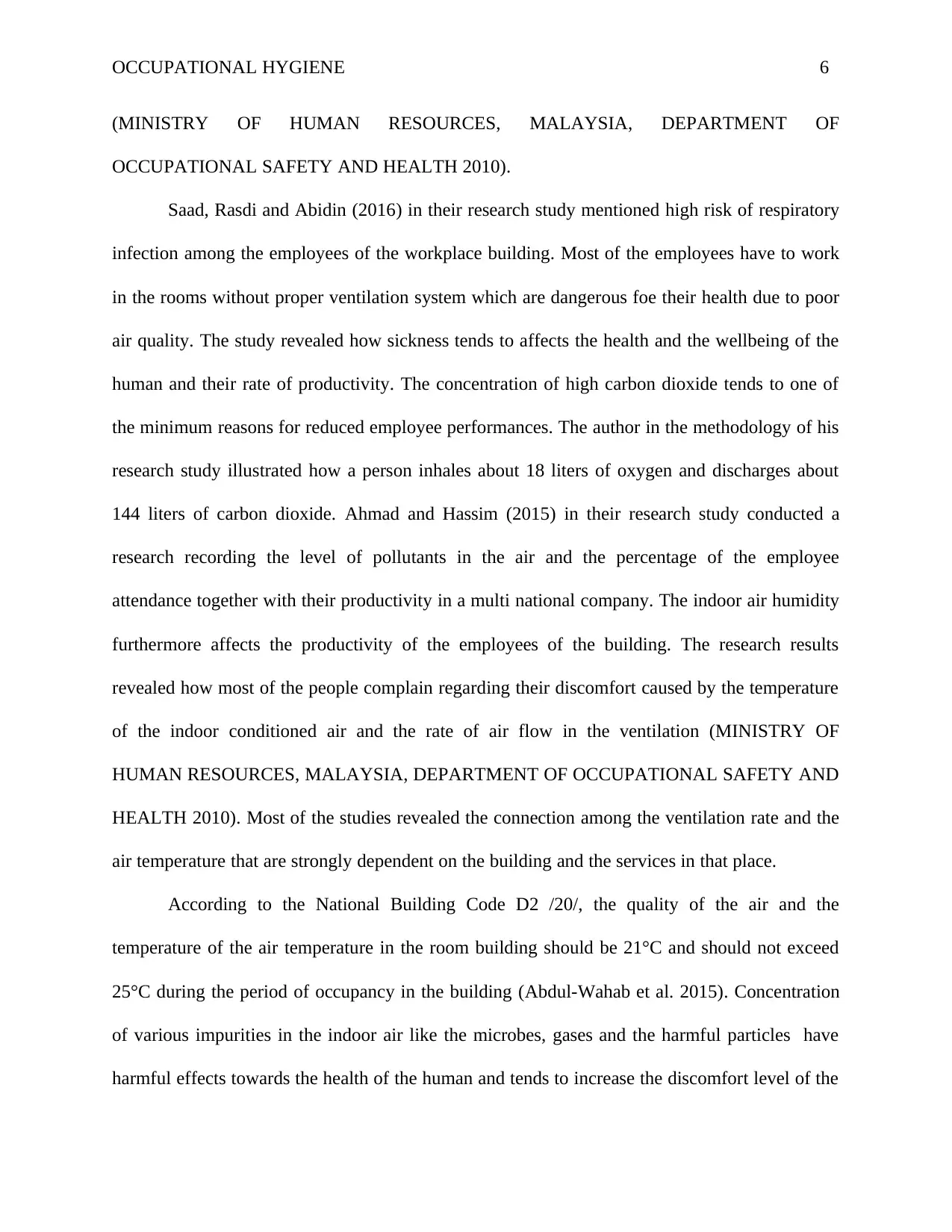
OCCUPATIONAL HYGIENE 6
(MINISTRY OF HUMAN RESOURCES, MALAYSIA, DEPARTMENT OF
OCCUPATIONAL SAFETY AND HEALTH 2010).
Saad, Rasdi and Abidin (2016) in their research study mentioned high risk of respiratory
infection among the employees of the workplace building. Most of the employees have to work
in the rooms without proper ventilation system which are dangerous foe their health due to poor
air quality. The study revealed how sickness tends to affects the health and the wellbeing of the
human and their rate of productivity. The concentration of high carbon dioxide tends to one of
the minimum reasons for reduced employee performances. The author in the methodology of his
research study illustrated how a person inhales about 18 liters of oxygen and discharges about
144 liters of carbon dioxide. Ahmad and Hassim (2015) in their research study conducted a
research recording the level of pollutants in the air and the percentage of the employee
attendance together with their productivity in a multi national company. The indoor air humidity
furthermore affects the productivity of the employees of the building. The research results
revealed how most of the people complain regarding their discomfort caused by the temperature
of the indoor conditioned air and the rate of air flow in the ventilation (MINISTRY OF
HUMAN RESOURCES, MALAYSIA, DEPARTMENT OF OCCUPATIONAL SAFETY AND
HEALTH 2010). Most of the studies revealed the connection among the ventilation rate and the
air temperature that are strongly dependent on the building and the services in that place.
According to the National Building Code D2 /20/, the quality of the air and the
temperature of the air temperature in the room building should be 21°C and should not exceed
25°C during the period of occupancy in the building (Abdul-Wahab et al. 2015). Concentration
of various impurities in the indoor air like the microbes, gases and the harmful particles have
harmful effects towards the health of the human and tends to increase the discomfort level of the
(MINISTRY OF HUMAN RESOURCES, MALAYSIA, DEPARTMENT OF
OCCUPATIONAL SAFETY AND HEALTH 2010).
Saad, Rasdi and Abidin (2016) in their research study mentioned high risk of respiratory
infection among the employees of the workplace building. Most of the employees have to work
in the rooms without proper ventilation system which are dangerous foe their health due to poor
air quality. The study revealed how sickness tends to affects the health and the wellbeing of the
human and their rate of productivity. The concentration of high carbon dioxide tends to one of
the minimum reasons for reduced employee performances. The author in the methodology of his
research study illustrated how a person inhales about 18 liters of oxygen and discharges about
144 liters of carbon dioxide. Ahmad and Hassim (2015) in their research study conducted a
research recording the level of pollutants in the air and the percentage of the employee
attendance together with their productivity in a multi national company. The indoor air humidity
furthermore affects the productivity of the employees of the building. The research results
revealed how most of the people complain regarding their discomfort caused by the temperature
of the indoor conditioned air and the rate of air flow in the ventilation (MINISTRY OF
HUMAN RESOURCES, MALAYSIA, DEPARTMENT OF OCCUPATIONAL SAFETY AND
HEALTH 2010). Most of the studies revealed the connection among the ventilation rate and the
air temperature that are strongly dependent on the building and the services in that place.
According to the National Building Code D2 /20/, the quality of the air and the
temperature of the air temperature in the room building should be 21°C and should not exceed
25°C during the period of occupancy in the building (Abdul-Wahab et al. 2015). Concentration
of various impurities in the indoor air like the microbes, gases and the harmful particles have
harmful effects towards the health of the human and tends to increase the discomfort level of the
You're viewing a preview
Unlock full access by subscribing today!
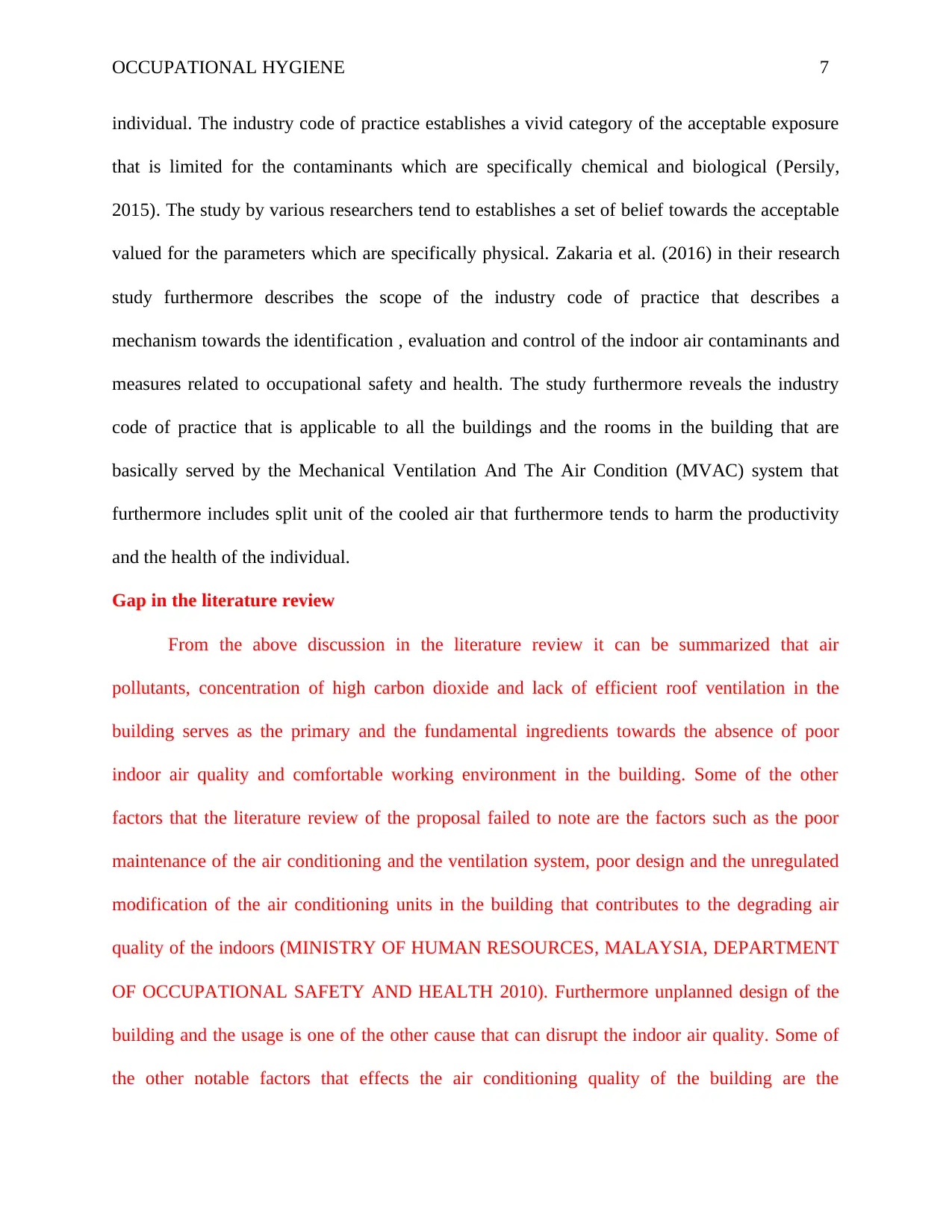
OCCUPATIONAL HYGIENE 7
individual. The industry code of practice establishes a vivid category of the acceptable exposure
that is limited for the contaminants which are specifically chemical and biological (Persily,
2015). The study by various researchers tend to establishes a set of belief towards the acceptable
valued for the parameters which are specifically physical. Zakaria et al. (2016) in their research
study furthermore describes the scope of the industry code of practice that describes a
mechanism towards the identification , evaluation and control of the indoor air contaminants and
measures related to occupational safety and health. The study furthermore reveals the industry
code of practice that is applicable to all the buildings and the rooms in the building that are
basically served by the Mechanical Ventilation And The Air Condition (MVAC) system that
furthermore includes split unit of the cooled air that furthermore tends to harm the productivity
and the health of the individual.
Gap in the literature review
From the above discussion in the literature review it can be summarized that air
pollutants, concentration of high carbon dioxide and lack of efficient roof ventilation in the
building serves as the primary and the fundamental ingredients towards the absence of poor
indoor air quality and comfortable working environment in the building. Some of the other
factors that the literature review of the proposal failed to note are the factors such as the poor
maintenance of the air conditioning and the ventilation system, poor design and the unregulated
modification of the air conditioning units in the building that contributes to the degrading air
quality of the indoors (MINISTRY OF HUMAN RESOURCES, MALAYSIA, DEPARTMENT
OF OCCUPATIONAL SAFETY AND HEALTH 2010). Furthermore unplanned design of the
building and the usage is one of the other cause that can disrupt the indoor air quality. Some of
the other notable factors that effects the air conditioning quality of the building are the
individual. The industry code of practice establishes a vivid category of the acceptable exposure
that is limited for the contaminants which are specifically chemical and biological (Persily,
2015). The study by various researchers tend to establishes a set of belief towards the acceptable
valued for the parameters which are specifically physical. Zakaria et al. (2016) in their research
study furthermore describes the scope of the industry code of practice that describes a
mechanism towards the identification , evaluation and control of the indoor air contaminants and
measures related to occupational safety and health. The study furthermore reveals the industry
code of practice that is applicable to all the buildings and the rooms in the building that are
basically served by the Mechanical Ventilation And The Air Condition (MVAC) system that
furthermore includes split unit of the cooled air that furthermore tends to harm the productivity
and the health of the individual.
Gap in the literature review
From the above discussion in the literature review it can be summarized that air
pollutants, concentration of high carbon dioxide and lack of efficient roof ventilation in the
building serves as the primary and the fundamental ingredients towards the absence of poor
indoor air quality and comfortable working environment in the building. Some of the other
factors that the literature review of the proposal failed to note are the factors such as the poor
maintenance of the air conditioning and the ventilation system, poor design and the unregulated
modification of the air conditioning units in the building that contributes to the degrading air
quality of the indoors (MINISTRY OF HUMAN RESOURCES, MALAYSIA, DEPARTMENT
OF OCCUPATIONAL SAFETY AND HEALTH 2010). Furthermore unplanned design of the
building and the usage is one of the other cause that can disrupt the indoor air quality. Some of
the other notable factors that effects the air conditioning quality of the building are the
Paraphrase This Document
Need a fresh take? Get an instant paraphrase of this document with our AI Paraphraser
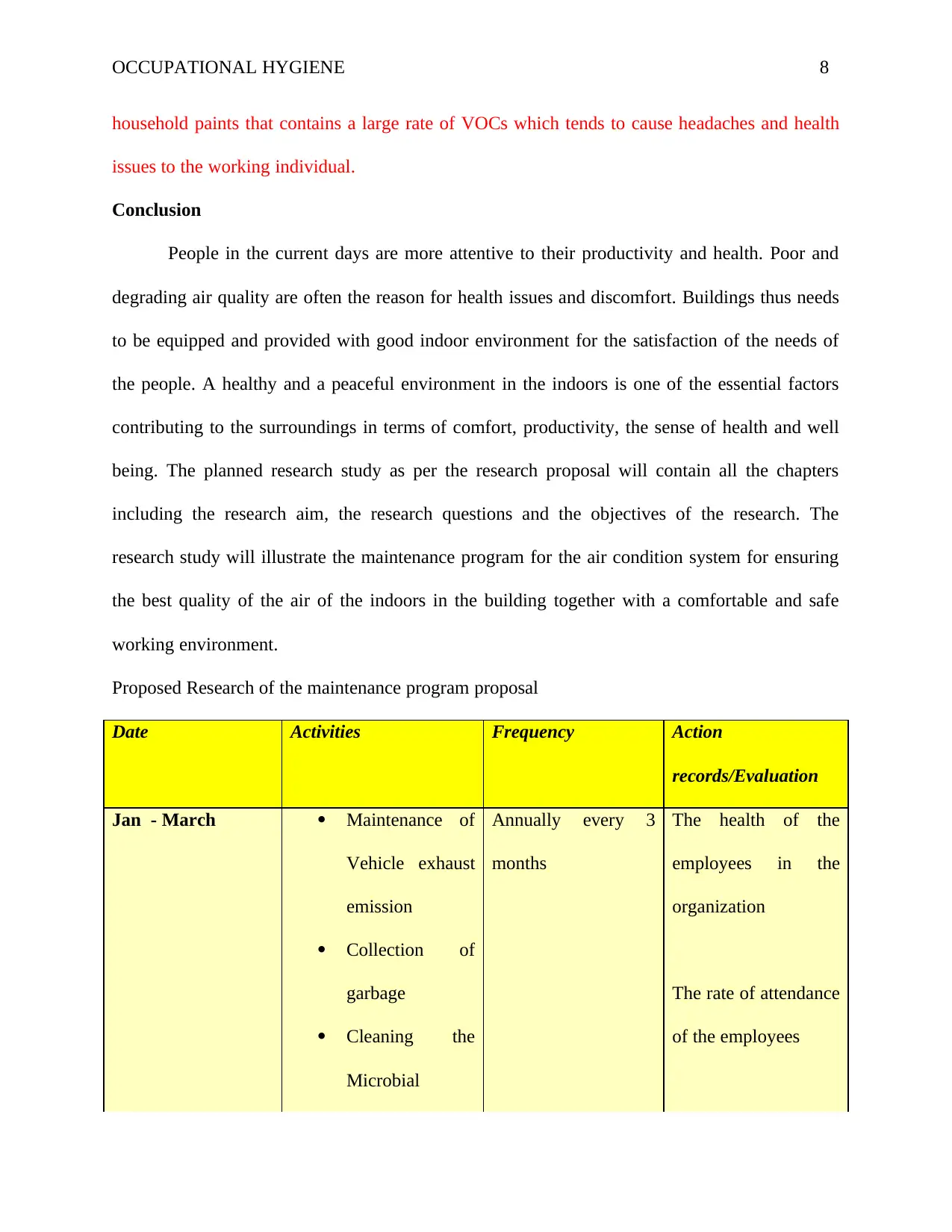
OCCUPATIONAL HYGIENE 8
household paints that contains a large rate of VOCs which tends to cause headaches and health
issues to the working individual.
Conclusion
People in the current days are more attentive to their productivity and health. Poor and
degrading air quality are often the reason for health issues and discomfort. Buildings thus needs
to be equipped and provided with good indoor environment for the satisfaction of the needs of
the people. A healthy and a peaceful environment in the indoors is one of the essential factors
contributing to the surroundings in terms of comfort, productivity, the sense of health and well
being. The planned research study as per the research proposal will contain all the chapters
including the research aim, the research questions and the objectives of the research. The
research study will illustrate the maintenance program for the air condition system for ensuring
the best quality of the air of the indoors in the building together with a comfortable and safe
working environment.
Proposed Research of the maintenance program proposal
Date Activities Frequency Action
records/Evaluation
Jan - March Maintenance of
Vehicle exhaust
emission
Collection of
garbage
Cleaning the
Microbial
Annually every 3
months
The health of the
employees in the
organization
The rate of attendance
of the employees
household paints that contains a large rate of VOCs which tends to cause headaches and health
issues to the working individual.
Conclusion
People in the current days are more attentive to their productivity and health. Poor and
degrading air quality are often the reason for health issues and discomfort. Buildings thus needs
to be equipped and provided with good indoor environment for the satisfaction of the needs of
the people. A healthy and a peaceful environment in the indoors is one of the essential factors
contributing to the surroundings in terms of comfort, productivity, the sense of health and well
being. The planned research study as per the research proposal will contain all the chapters
including the research aim, the research questions and the objectives of the research. The
research study will illustrate the maintenance program for the air condition system for ensuring
the best quality of the air of the indoors in the building together with a comfortable and safe
working environment.
Proposed Research of the maintenance program proposal
Date Activities Frequency Action
records/Evaluation
Jan - March Maintenance of
Vehicle exhaust
emission
Collection of
garbage
Cleaning the
Microbial
Annually every 3
months
The health of the
employees in the
organization
The rate of attendance
of the employees
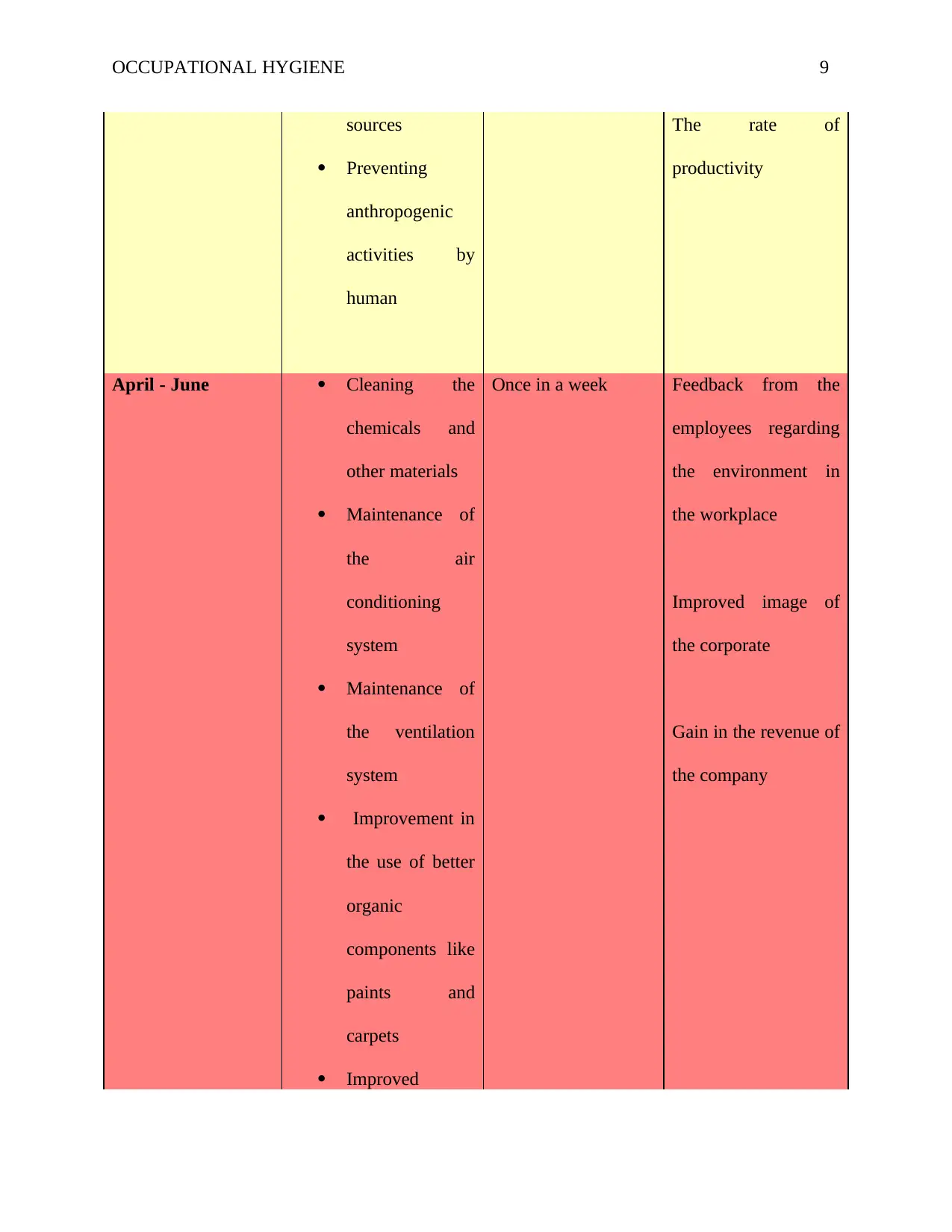
OCCUPATIONAL HYGIENE 9
sources
Preventing
anthropogenic
activities by
human
The rate of
productivity
April - June Cleaning the
chemicals and
other materials
Maintenance of
the air
conditioning
system
Maintenance of
the ventilation
system
Improvement in
the use of better
organic
components like
paints and
carpets
Improved
Once in a week Feedback from the
employees regarding
the environment in
the workplace
Improved image of
the corporate
Gain in the revenue of
the company
sources
Preventing
anthropogenic
activities by
human
The rate of
productivity
April - June Cleaning the
chemicals and
other materials
Maintenance of
the air
conditioning
system
Maintenance of
the ventilation
system
Improvement in
the use of better
organic
components like
paints and
carpets
Improved
Once in a week Feedback from the
employees regarding
the environment in
the workplace
Improved image of
the corporate
Gain in the revenue of
the company
You're viewing a preview
Unlock full access by subscribing today!
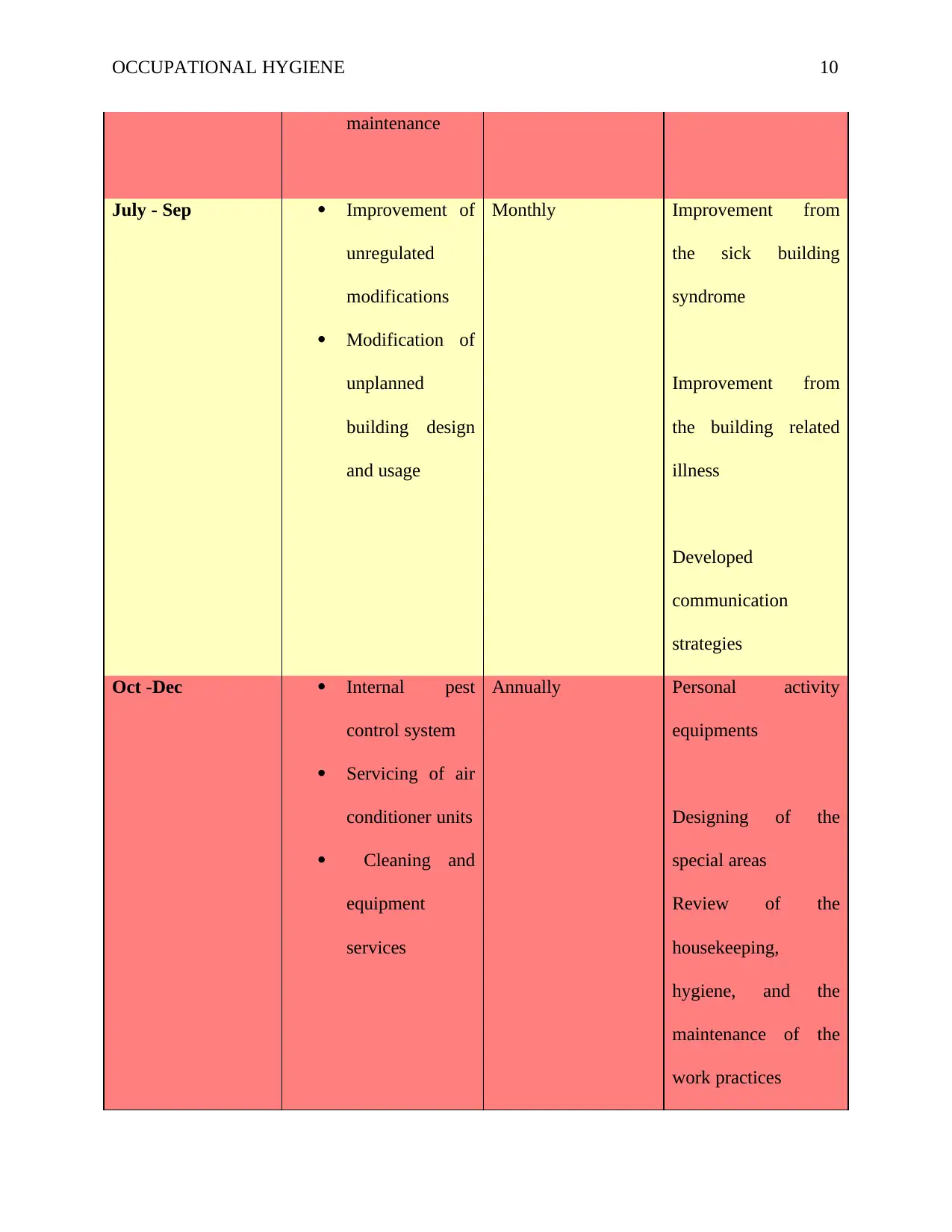
OCCUPATIONAL HYGIENE 10
maintenance
July - Sep Improvement of
unregulated
modifications
Modification of
unplanned
building design
and usage
Monthly Improvement from
the sick building
syndrome
Improvement from
the building related
illness
Developed
communication
strategies
Oct -Dec Internal pest
control system
Servicing of air
conditioner units
Cleaning and
equipment
services
Annually Personal activity
equipments
Designing of the
special areas
Review of the
housekeeping,
hygiene, and the
maintenance of the
work practices
maintenance
July - Sep Improvement of
unregulated
modifications
Modification of
unplanned
building design
and usage
Monthly Improvement from
the sick building
syndrome
Improvement from
the building related
illness
Developed
communication
strategies
Oct -Dec Internal pest
control system
Servicing of air
conditioner units
Cleaning and
equipment
services
Annually Personal activity
equipments
Designing of the
special areas
Review of the
housekeeping,
hygiene, and the
maintenance of the
work practices
Paraphrase This Document
Need a fresh take? Get an instant paraphrase of this document with our AI Paraphraser

OCCUPATIONAL HYGIENE 11
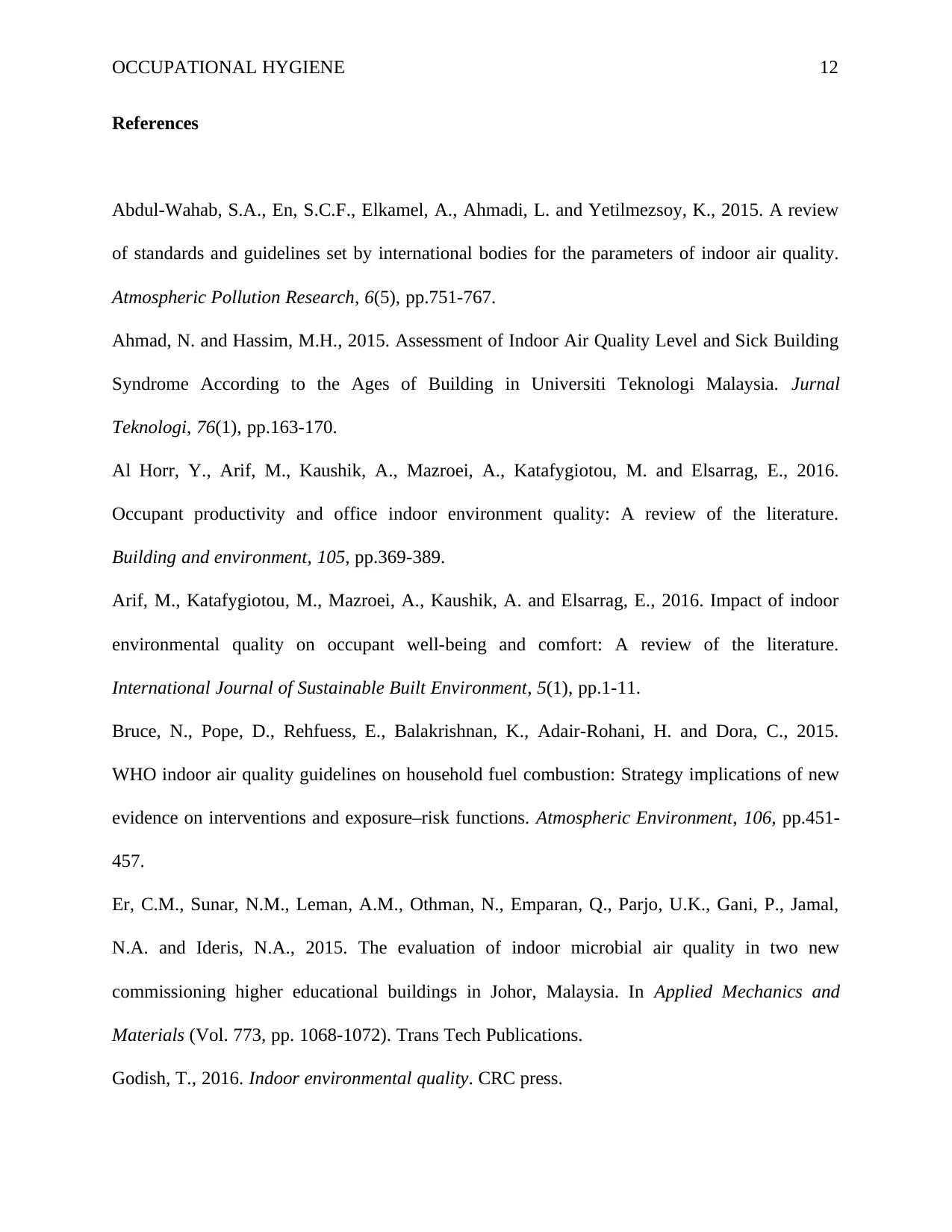
OCCUPATIONAL HYGIENE 12
References
Abdul-Wahab, S.A., En, S.C.F., Elkamel, A., Ahmadi, L. and Yetilmezsoy, K., 2015. A review
of standards and guidelines set by international bodies for the parameters of indoor air quality.
Atmospheric Pollution Research, 6(5), pp.751-767.
Ahmad, N. and Hassim, M.H., 2015. Assessment of Indoor Air Quality Level and Sick Building
Syndrome According to the Ages of Building in Universiti Teknologi Malaysia. Jurnal
Teknologi, 76(1), pp.163-170.
Al Horr, Y., Arif, M., Kaushik, A., Mazroei, A., Katafygiotou, M. and Elsarrag, E., 2016.
Occupant productivity and office indoor environment quality: A review of the literature.
Building and environment, 105, pp.369-389.
Arif, M., Katafygiotou, M., Mazroei, A., Kaushik, A. and Elsarrag, E., 2016. Impact of indoor
environmental quality on occupant well-being and comfort: A review of the literature.
International Journal of Sustainable Built Environment, 5(1), pp.1-11.
Bruce, N., Pope, D., Rehfuess, E., Balakrishnan, K., Adair-Rohani, H. and Dora, C., 2015.
WHO indoor air quality guidelines on household fuel combustion: Strategy implications of new
evidence on interventions and exposure–risk functions. Atmospheric Environment, 106, pp.451-
457.
Er, C.M., Sunar, N.M., Leman, A.M., Othman, N., Emparan, Q., Parjo, U.K., Gani, P., Jamal,
N.A. and Ideris, N.A., 2015. The evaluation of indoor microbial air quality in two new
commissioning higher educational buildings in Johor, Malaysia. In Applied Mechanics and
Materials (Vol. 773, pp. 1068-1072). Trans Tech Publications.
Godish, T., 2016. Indoor environmental quality. CRC press.
References
Abdul-Wahab, S.A., En, S.C.F., Elkamel, A., Ahmadi, L. and Yetilmezsoy, K., 2015. A review
of standards and guidelines set by international bodies for the parameters of indoor air quality.
Atmospheric Pollution Research, 6(5), pp.751-767.
Ahmad, N. and Hassim, M.H., 2015. Assessment of Indoor Air Quality Level and Sick Building
Syndrome According to the Ages of Building in Universiti Teknologi Malaysia. Jurnal
Teknologi, 76(1), pp.163-170.
Al Horr, Y., Arif, M., Kaushik, A., Mazroei, A., Katafygiotou, M. and Elsarrag, E., 2016.
Occupant productivity and office indoor environment quality: A review of the literature.
Building and environment, 105, pp.369-389.
Arif, M., Katafygiotou, M., Mazroei, A., Kaushik, A. and Elsarrag, E., 2016. Impact of indoor
environmental quality on occupant well-being and comfort: A review of the literature.
International Journal of Sustainable Built Environment, 5(1), pp.1-11.
Bruce, N., Pope, D., Rehfuess, E., Balakrishnan, K., Adair-Rohani, H. and Dora, C., 2015.
WHO indoor air quality guidelines on household fuel combustion: Strategy implications of new
evidence on interventions and exposure–risk functions. Atmospheric Environment, 106, pp.451-
457.
Er, C.M., Sunar, N.M., Leman, A.M., Othman, N., Emparan, Q., Parjo, U.K., Gani, P., Jamal,
N.A. and Ideris, N.A., 2015. The evaluation of indoor microbial air quality in two new
commissioning higher educational buildings in Johor, Malaysia. In Applied Mechanics and
Materials (Vol. 773, pp. 1068-1072). Trans Tech Publications.
Godish, T., 2016. Indoor environmental quality. CRC press.
You're viewing a preview
Unlock full access by subscribing today!
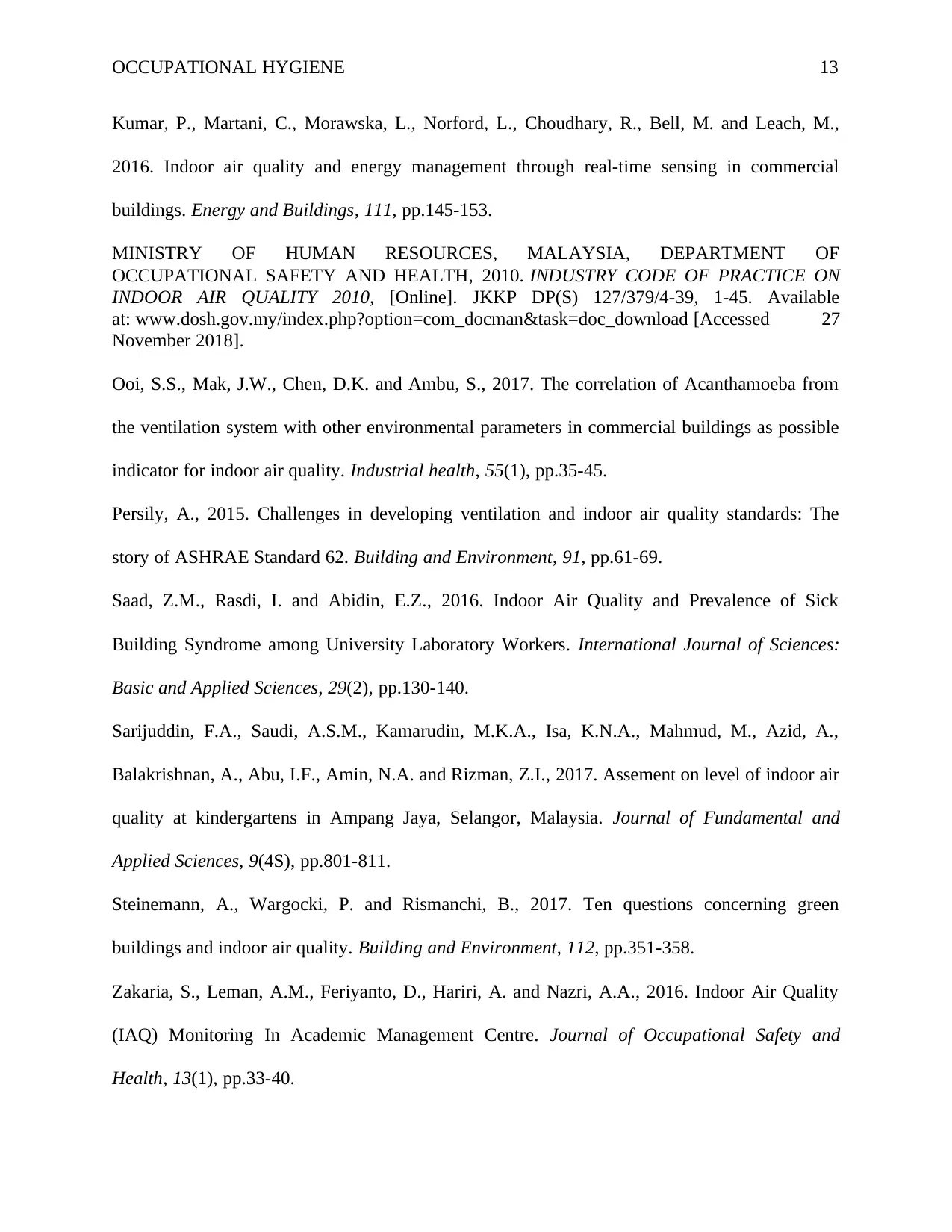
OCCUPATIONAL HYGIENE 13
Kumar, P., Martani, C., Morawska, L., Norford, L., Choudhary, R., Bell, M. and Leach, M.,
2016. Indoor air quality and energy management through real-time sensing in commercial
buildings. Energy and Buildings, 111, pp.145-153.
MINISTRY OF HUMAN RESOURCES, MALAYSIA, DEPARTMENT OF
OCCUPATIONAL SAFETY AND HEALTH, 2010. INDUSTRY CODE OF PRACTICE ON
INDOOR AIR QUALITY 2010, [Online]. JKKP DP(S) 127/379/4-39, 1-45. Available
at: www.dosh.gov.my/index.php?option=com_docman&task=doc_download [Accessed 27
November 2018].
Ooi, S.S., Mak, J.W., Chen, D.K. and Ambu, S., 2017. The correlation of Acanthamoeba from
the ventilation system with other environmental parameters in commercial buildings as possible
indicator for indoor air quality. Industrial health, 55(1), pp.35-45.
Persily, A., 2015. Challenges in developing ventilation and indoor air quality standards: The
story of ASHRAE Standard 62. Building and Environment, 91, pp.61-69.
Saad, Z.M., Rasdi, I. and Abidin, E.Z., 2016. Indoor Air Quality and Prevalence of Sick
Building Syndrome among University Laboratory Workers. International Journal of Sciences:
Basic and Applied Sciences, 29(2), pp.130-140.
Sarijuddin, F.A., Saudi, A.S.M., Kamarudin, M.K.A., Isa, K.N.A., Mahmud, M., Azid, A.,
Balakrishnan, A., Abu, I.F., Amin, N.A. and Rizman, Z.I., 2017. Assement on level of indoor air
quality at kindergartens in Ampang Jaya, Selangor, Malaysia. Journal of Fundamental and
Applied Sciences, 9(4S), pp.801-811.
Steinemann, A., Wargocki, P. and Rismanchi, B., 2017. Ten questions concerning green
buildings and indoor air quality. Building and Environment, 112, pp.351-358.
Zakaria, S., Leman, A.M., Feriyanto, D., Hariri, A. and Nazri, A.A., 2016. Indoor Air Quality
(IAQ) Monitoring In Academic Management Centre. Journal of Occupational Safety and
Health, 13(1), pp.33-40.
Kumar, P., Martani, C., Morawska, L., Norford, L., Choudhary, R., Bell, M. and Leach, M.,
2016. Indoor air quality and energy management through real-time sensing in commercial
buildings. Energy and Buildings, 111, pp.145-153.
MINISTRY OF HUMAN RESOURCES, MALAYSIA, DEPARTMENT OF
OCCUPATIONAL SAFETY AND HEALTH, 2010. INDUSTRY CODE OF PRACTICE ON
INDOOR AIR QUALITY 2010, [Online]. JKKP DP(S) 127/379/4-39, 1-45. Available
at: www.dosh.gov.my/index.php?option=com_docman&task=doc_download [Accessed 27
November 2018].
Ooi, S.S., Mak, J.W., Chen, D.K. and Ambu, S., 2017. The correlation of Acanthamoeba from
the ventilation system with other environmental parameters in commercial buildings as possible
indicator for indoor air quality. Industrial health, 55(1), pp.35-45.
Persily, A., 2015. Challenges in developing ventilation and indoor air quality standards: The
story of ASHRAE Standard 62. Building and Environment, 91, pp.61-69.
Saad, Z.M., Rasdi, I. and Abidin, E.Z., 2016. Indoor Air Quality and Prevalence of Sick
Building Syndrome among University Laboratory Workers. International Journal of Sciences:
Basic and Applied Sciences, 29(2), pp.130-140.
Sarijuddin, F.A., Saudi, A.S.M., Kamarudin, M.K.A., Isa, K.N.A., Mahmud, M., Azid, A.,
Balakrishnan, A., Abu, I.F., Amin, N.A. and Rizman, Z.I., 2017. Assement on level of indoor air
quality at kindergartens in Ampang Jaya, Selangor, Malaysia. Journal of Fundamental and
Applied Sciences, 9(4S), pp.801-811.
Steinemann, A., Wargocki, P. and Rismanchi, B., 2017. Ten questions concerning green
buildings and indoor air quality. Building and Environment, 112, pp.351-358.
Zakaria, S., Leman, A.M., Feriyanto, D., Hariri, A. and Nazri, A.A., 2016. Indoor Air Quality
(IAQ) Monitoring In Academic Management Centre. Journal of Occupational Safety and
Health, 13(1), pp.33-40.
Paraphrase This Document
Need a fresh take? Get an instant paraphrase of this document with our AI Paraphraser

OCCUPATIONAL HYGIENE 14
1 out of 14
Related Documents
Your All-in-One AI-Powered Toolkit for Academic Success.
+13062052269
info@desklib.com
Available 24*7 on WhatsApp / Email
![[object Object]](/_next/static/media/star-bottom.7253800d.svg)
Unlock your academic potential
© 2024 | Zucol Services PVT LTD | All rights reserved.





